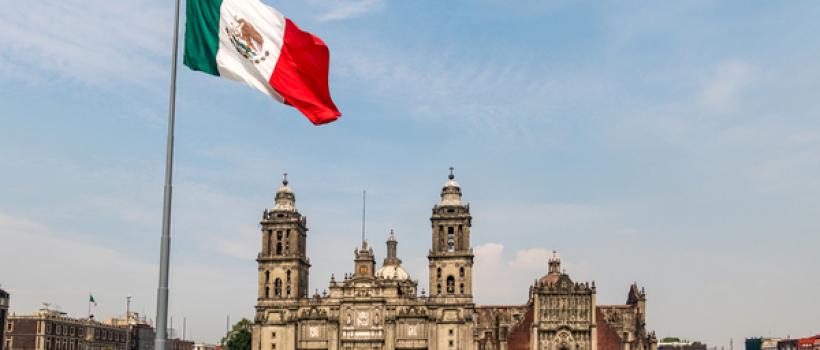
Shipping to Mexico and other emerging markets is one solution for companies looking to hedge against slowdowns in more mature markets. Of the many emerging markets in Latin America, Mexico perhaps offers the most promise for international companies. But there are still many myths and misconceptions about the country that may give foreign companies pause before doing business there.
We’ll introduce you to Mexico’s culture and economy and provide some insights into shipping to Mexico from the U.S. to ensure that you avoid any difficulties and can provide your customers with the best possible experience.
Spotlight on Mexico
Mexico is a large, diverse country, whose most common image might be the white sandy beaches of its many resort towns. The country, which has over 130 million citizens, has much more to offer than tourism, though.

Mexico has a lot more to offer than white sandy beaches. - Image source
In fact, while many people think of New York City as the biggest metropolitan area in the Western Hemisphere, Mexico City surpasses it to take the crown. Today, Mexico City is populated by native Mexicans and immigrants from countries across the globe. The region has historically formed an important part of Western civilization, dating back to the Aztec Empire.
Beyond a diverse geography and people, Mexico is rich in many natural resources, including precious metals, minerals, and oil reserves. When you add in Mexico’s agricultural capabilities, these factors make the country an important source of goods for local and international markets.
With a wealth of resources, there has been a push throughout the twentieth century to raise the standard of living for Mexico’s citizens. The last few decades, coinciding with the enforcement of the North American Free Trade Agreement (NAFTA), have seen mixed results, with slow growth (18th worst average per-capita output in the region) between 1994-2013 and no improvement in the poverty rate since the agreement went into effect, although there has been expansion in the middle class and growth of specific sectors like car manufacturing. Still, the country continues to undergo many changes, thanks to influences at home and abroad.
Mexico’s Economy
Mexico is a strong market for foreign companies looking to broaden their international foothold. Since NAFTA, Mexico’s economy has become more privatized and open to foreign investment. According to the Washington Post, Mexican President López Obrador, despite his leftist stance, “recognizes that to help his primary constituency—the poor and disadvantaged—he must grow the economy, and he understands that economic growth comes from a competitive private economy, not from government.”
Thanks to Mexico’s pro-trade stances and increasing privatization, international trade makes up 66% of the country’s gross domestic product, which is the 15th largest in the world.
Mexico may be situated between the U.S. and the rest of Latin America geographically, but from a business standpoint, Mexico also provides a great entry point into the Latin American markets. Many businesses are fluent in English (although it is respectful to have an interpreter), and there are many shared cultural values between the two countries.
Doing Business in Mexico
Like much of Latin America, Mexico has seen its middle class grow in the 21st century. This growing middle class has more access to credit, technology like the internet and mobile devices, and is willing to spend money on consumer products.
Thanks to NAFTA, Mexico is a large importer of U.S. retail goods. - Image source
For these reasons, Mexico is seeing explosive e-commerce growth. E-commerce revenue is growing over 16% per year from nearly 38 million online shoppers, and an estimated 18 million more shoppers are expected to come online by 2020. Many of those shoppers, up to 64%, are turning towards U.S. e-commerce retailers for their purchases.
While Mexico’s economy continues to grow, there are several general challenges facing foreign entrants into the Mexican market:
-
A geographically and demographically diverse country requires targeted market entry.
-
Malls are thriving in the country, but many still shop at small, local markets.
-
The Mexican legal system is profoundly different from the U.S., and special care should be taken when entering into the market to comply with all laws.
-
Business culture is run differently in Mexico; according to TMF Group, meetings are slow and decisions are often unilateral.
Top Industries for Exporters
As everyone from consumers to businesses in Mexico turn to online retailers, the market opportunities for foreign companies will continue to grow. According to export.gov, Mexico’s growing economy will open up opportunities in a wide range of industries, from agribusiness, to information technology, to auto parts, and more all shipping to Mexico.
Mexico imports a whopping 41% of its total goods from the U.S., including machinery, vehicles, high-tech medical instruments, services, and plastic goods.
Moving forward, exporters can look to demographic trends to see if Mexico is the right fit for their business. Approximately 79% of the population lives in an urban area. Furthermore, the population is incredibly young—with a median age of 28—and quickly adapting to modern digital life.
Shipping to Mexico
When shipping to Mexico, the customs process and last mile delivery make the difference in price and speed—for both you and your customers. Thus, it’s important to know how to navigate these areas if your company is going to succeed in the country.
Last Mile Delivery
The post in Mexico, Correos de México, was established in 2008 to replace the previous department, Sepomex (Servicio Postal Mexicano). As in many other Latin American countries, the post suffers from a variety of issues including package theft, long wait times, and difficulty with addresses.
While the post delivers to home addresses, many people rely on P.O. boxes in Mexico since street names and addresses aren’t always clear. This is especially true in the more rural parts of the country. In the case of P.O. boxes, Correos will handle the “last mile” delivery by sending a package receipt to the recipient’s house; these receipts are easily lost or misplaced.
Luckily, most of Mexico’s population live in urban areas like Mexico City. - Image source
While shipping to Mexico using Correos is inexpensive, it’s slow and packages—especially small ones—are susceptible to theft. Choosing a shipping solution that offers package tracking and third-party delivery services is worth the cost to ensure last mile delivery success.
Navigating Customs
To successfully navigate the customs process when shipping to Mexico, compliance is critical. For large-scale export operations, in particular, it’s advisable to work with a Mexican Custom Broker to help navigate the legal requirements. Still, even smaller e-commerce retailers who rely on marketplaces like eBay and Amazon need to understand the required documentation and idiosyncrasies of the system.
Essential Paperwork
According to export.gov, in order to export to Mexico and get through customs you need the following documentation:
-
Import/export form for all commercial crossing
-
Commercial invoice (in Spanish)
-
Bill of lading
-
Documents demonstrating guarantee of payment of additional duties
-
Documents demonstrating compliance with Mexican product safety and performance regulations (if applicable)
Thanks to NAFTA, a Certificate of Origin (indicating the product was made in North America) may be included by the exporter to provide preferential treatment for those goods while going through customs.
Customs Quirks
Like every country, Mexico’s customs has some unique qualities. One of the most important is that imported goods are subject to a 16% Value Added Tax (VAT). This isn’t necessarily a disadvantage for exporters though, as the VAT is applicable to local companies selling goods in Mexico, as well.
Special taxes on certain items, including alcoholic beverages, cigarettes, cigars, soda, and junk food are also in place, ranging from 25-160% of the product’s value.
For e-commerce retailers in particular, it’s important to understand the de minimis rules for private and commercial shipments. For U.S. companies shipping to Mexico, any shipment above $50 is subject to duties, regulations, and clearance procedures. When exporting from Mexico to the U.S., the de minimis is much higher at $800.
When shipping to Mexico through the post, the de minimis is higher—up to $300. For both courier and post shipments, the maximum value of goods shipped is $1,000.
Certain items are subject to anti-dumping measures and are restricted for importation to Mexico. See the current list here.
Resources for Shipping to Mexico
Thanks to Mexico’s strong trade relations with the U.S. and various other countries, there are many resources to help companies navigate the process of shipping to Mexico.
A great starting point is export.gov’s Country Commercial Guide, which provides a comprehensive introduction to doing business in Mexico (and other countries around the world).
If your company is interested in more specific advice about shipping to Mexico, finding a trusted logistics partner with a background and business presence in the country is critical. Thanks to SkyPostal’s decades of experience shipping to Mexico and the rest of Latin America, we can provide your business with:
-
The largest private delivery network in Latin America
-
Fully trackable packages
-
Integrated data and tracking management
-
Customs clearance and duty collection
Contact us today to see why SkyPostal has been trusted for years by some of the world’s largest retailers to make shipping to Mexico a reality.

